Accepted Scientific Name: Mestoklema arboriforme (Burch.) N.E.Br.
1936, Ser. III. c. 165.
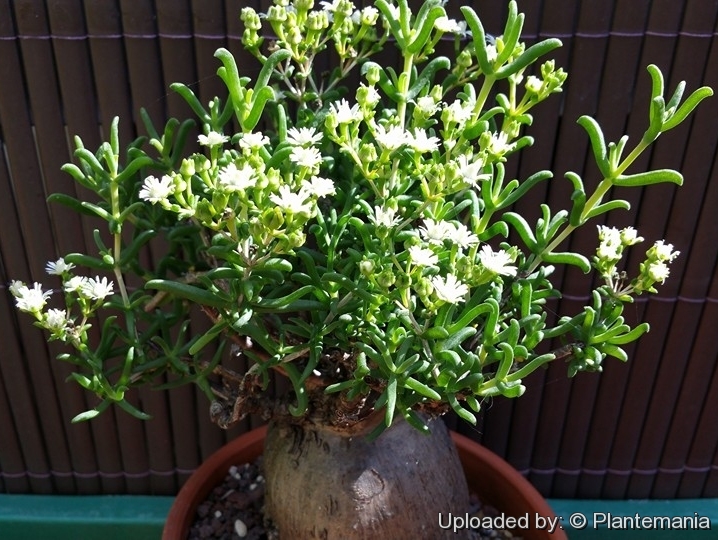
Mesembryanthemum arboriforme (Mestoklema arboriforme) Photo by: © Plantemania
Origin and Habitat: North-Eastern districts of Northern Cape of South Africa, Eastern districts of Free State, and into Namibia.
Type locality: Cape, between Wittewater and Rietfontein.
Habitat: It grows often in large populations in arid plains in low open herbland on loamy or stony soil.
Synonyms:
Common Names include:
ENGLISH: Donkey Mesemb
AFRIKAANS (Afrikaans): Donkiebossie, Donkiebos, Donkievy
Description: Mestoklema arboriformeSN|875]]SN|875]] is a small shrubby "Mesemb" (ice plant relative) 25-60 cm tall that develops a miniature tree like habit with a gnarled tuberous rootstock .
Rootstock (Caudex): Tuberous, branched with smooth red bark. In habitat the fat rootstock grows buried in the ground, but in cultivation, once the tuberous roots develop, the plant is lifted above soil level and replanted with roots exposed making a very showy bonsai-like specimen.
Stem: Intricately branched. The old stems appear to vary in colour, some turning more orange in colour than blackish-brown.
Leaves: 5-15 mm long, 1,1-1.5 mm wide.
Inflorescences: 3-6-branched cymes, about 30-60 mm in diameter. Pedicel 1-5 mm long.
Flowers: Small 7-10 mm in diameter, whitish to yellow-orange. Petals 20 to 25, 4-5 mm long.
Blooming season: Flowers appear in spring, plants start flowering at an early age often when only 6 month old.
Fruits: About 3 mm in diameter, stalks approx. 10 mm long.
Seeds: 0,7 x 0,5 mm.
Remarks: There are contrasting opinions on whether the plants commonly found in culture are Mestoklema tuberosa or Mestoklema arboriformeSN|875]]SN|875]]. The one and the other have dull white, yellow or orange flowers and the description of these two taxa in Jacobsen is obscure enough that it could be either.
Bibliography: Major references and further lectures
1) H. E. K. Hartmann “Illustrated Handbook of Succulent Plants: Aizoaceae F-Z” Springer, 2002
2) Raimondo, D., von Staden, L., Foden, W., Victor, J.E., Helme, N.A., Turner, R.C., Kamundi, D.A. and Manyama, P.A. 2009. “Red List of South African Plants.” Strelitzia 25. South African National Biodiversity Institute, Pretoria.
3) Burgoyne, P.M. 2006. “Mestoklema arboriforme” (Burch.) N.E.Br. ex Glen. “National Assessment: Red List of South African Plants” version 2013.1. Accessed on 2013/05/04
4) Environmental Assurance (Pty) Ltd “DRAFT: Plant Ecological Report: For the proposed alternative energy plant on !Xun & Khwe also known as Platfontein 68 & Wildebeestkuil 69” January 2012
5) Hermann Jacobsen “A handbook of succulent plants: descriptions, synonyms, and cultural details for succulents other than Cactaceae” Blandford Press, 1960
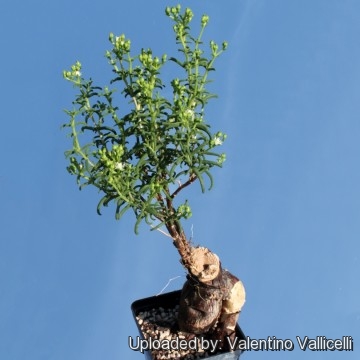 Mesembryanthemum arboriforme (Mestoklema arboriforme) Photo by: Valentino Vallicelli
Mesembryanthemum arboriforme (Mestoklema arboriforme) Photo by: Valentino Vallicelli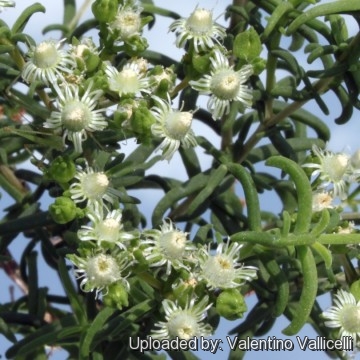 Mesembryanthemum arboriforme (Mestoklema arboriforme) Photo by: Valentino Vallicelli
Mesembryanthemum arboriforme (Mestoklema arboriforme) Photo by: Valentino Vallicelli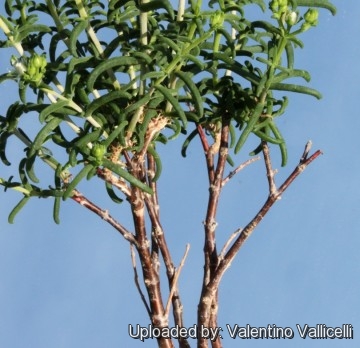 Mesembryanthemum arboriforme (Mestoklema arboriforme) Photo by: Valentino Vallicelli
Mesembryanthemum arboriforme (Mestoklema arboriforme) Photo by: Valentino Vallicelli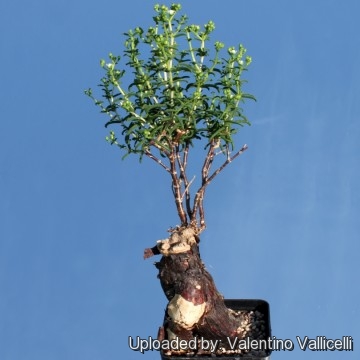 Mesembryanthemum arboriforme (Mestoklema arboriforme) Photo by: Valentino Vallicelli
Mesembryanthemum arboriforme (Mestoklema arboriforme) Photo by: Valentino Vallicelli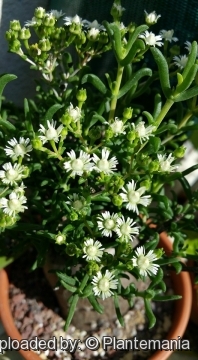 Mesembryanthemum arboriforme (Mestoklema arboriforme) Photo by: © Plantemania
Mesembryanthemum arboriforme (Mestoklema arboriforme) Photo by: © Plantemania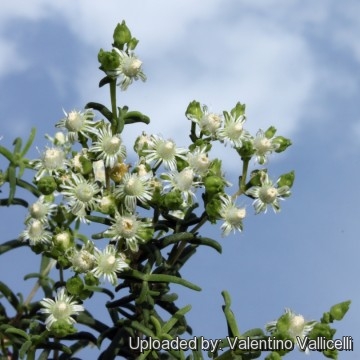 Mesembryanthemum arboriforme (Mestoklema arboriforme) Photo by: Valentino Vallicelli
Mesembryanthemum arboriforme (Mestoklema arboriforme) Photo by: Valentino Vallicelli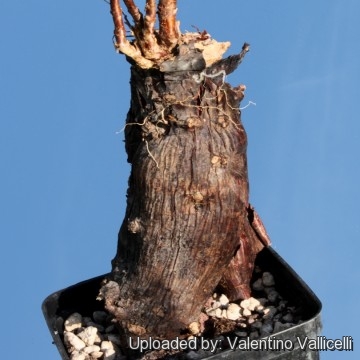 Mesembryanthemum arboriforme (Mestoklema arboriforme) Photo by: Valentino Vallicelli
Mesembryanthemum arboriforme (Mestoklema arboriforme) Photo by: Valentino Vallicelli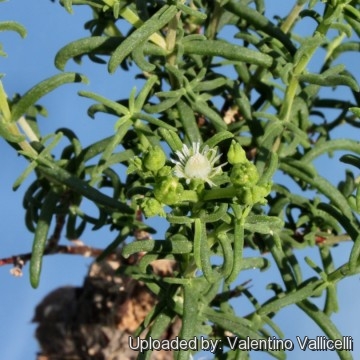 Mesembryanthemum arboriforme (Mestoklema arboriforme) Photo by: Valentino Vallicelli
Mesembryanthemum arboriforme (Mestoklema arboriforme) Photo by: Valentino VallicelliCultivation and Propagation: Although regarded as a choice and difficult plant, in cultivation it is relatively easy. It is a particular favourite of caudiciform plant enthusiasts.
Growth rate: Plants grow very slowly and caudex take many years to enlarge. Clustering in cultivation, if grown correctly, it will reward the grower with generous displays of tiny flowers.
Caudex exposure: The remarkable tuberous rootstock (caudex) is often raised above the soil line so that this can be seen and more readily appreciated. For best results the tuber must be exposed only when plans become mature enough, usually after several years (8-12 or more years) of underground growth, as the exposed caudex will no longer increase in size once it has been lifted above the soil line.
Potting medium: Use a cactus mix or add extra perlite or pumice to regular soil potting soil. A gritty, very free-draining compost is suitable, and clay pots help the plants to dry out between watering. For best results, use a deep pot.
Fertilization: Need a perfect fertilizer diet in summer. Use preferably a cacti and succulents fertilizer with high potassium content including all micro nutrients and trace elements or slow release fertilizer.
Watering Needs: Water normally in the growing season from March to October. No water should ever be allowed to stand around the roots. Keep almost completely dry in winter. The swollen caudex makes it very tolerant of under watering.
Hardiness: It is quite frost resistant if kept dry, hardy as low as -5° C. It can be grown outdoors in the summer months to benefit from direct exposure to light, and especially exposure to high summer temperatures. Recommended Temperature Zone: USDA 10-12.
Sun Exposure: This plant has an excellent heat tolerance, and need full sun to light shade exposures. High levels of light are needed to flower and for good plant development.
Rot: Rot it is only a minor problem with Mestoklema if the plants are watered and “aired” correctly. If they are not, fungicides won't help all that much. The plant turns immediately to mush when over watered, or watered out of season. Care must be given in watering, keeping them warm and wet while growing, and cooler and dry when dormant.
Reproduction: Seeds or cuttings. The seed should be planted as soon after harvesting as possible. Germination usually occurs within about a week or two. Seed germinate at 15-21 °C.



















